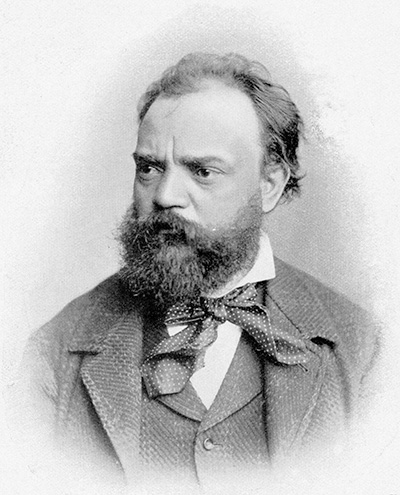Antonín Dvořák

- Born: September 8, 1841, Nelahozeves (near Prague),
Czechia (Austrian Empire) - Died: May 1, 1904, Prague, Czechia
Largo from Symphony No. 9 in E Minor, Op. 95, From the New World
- Composed: 1892-93
- Premiere: December 16, 1893, New York, New York Philharmonic Orchestra, Anton Seidl conducting
- Instrumentation: 2 flutes, 2 oboes (incl. English horn), 2 clarinets, 2 bassoons, 4 horns, 2 trumpets, 3 trombones, tuba, timpani, strings
- CSO notable performances: First (full symphony): February 1895, Anton Seidl conducting. Most Recent (full symphony): October 2019, Gustavo Gimeno conducting.
- Duration: approx. 12 minutes
When Antonín Dvořák arrived in New York City in September 1892 to direct the new National Conservatory of Music, both he and the institution’s founder, Mrs. Jeanette Thurber, expected he would tfoster an American school of composition. He said, “I am convinced the future music of this country must be founded on what are called Negro melodies. They can be the foundation of a serious and original school of composition in the United States.” The “New World” Symphony was not only Dvořák’s way of pointing toward a truly American musical idiom but also a reflection of his own feelings about the country. “I should never have written the Symphony as I have,” he said, “if I hadn’t seen America.”
The “New World” Symphony scored an enormous success at its premiere, on December 16, 1893 in Carnegie Hall (the box where the composer sat that evening is marked with a commemorative plaque) and immediately entered the international repertory; it became Dvořák’s most popular work. Especially beloved is the English horn theme from the second movement (Largo), an original but perfect analogue of an American spiritual. In 1922, William Arms Fisher (1861–1948), a composition student of Dvořák's at the National Conservatory, eventually a teacher at the school and later president of both the Music Teachers National Association and Music Publishers’ National Association, added text to the poignant melody to create the hymn Goin’ Home: Goin’ home, goin’ home,/I’m just goin’ home,/Quiet like some still day,/I’m just goin’ home./Mother’s there ‘spectin’ me,/And father’s waitin’ too,/Lots of folk are gathered there,/With the friends I knew.
Dr. Richard E. Rodda